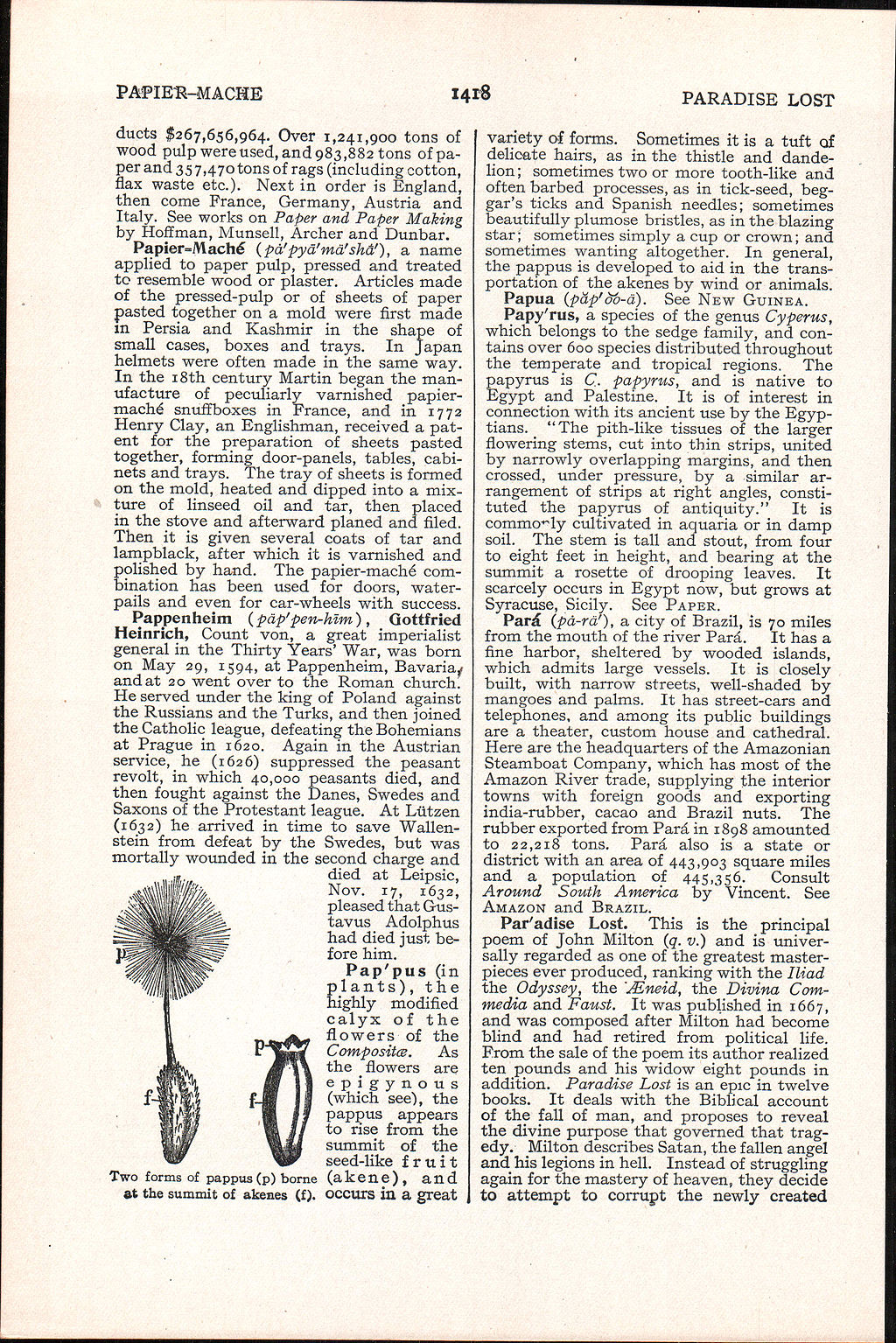PAPIER-MACHE
1418
PARADISE LOST
ducts $267,656,964. Over 1,241,900 tons of wood pulp were used, and 983,882 tons of paper and 357,470 tons of rags (including cotton, flax waste etc.). Next in order is England, then come France, Germany, Austria and Italy. See works on Paper and Paper Making by Hoffman, Munsell, Archer and Dunbar.
Papier-Mach£ (pa'pya'ma'sha'), a name applied to paper pulp, pressed and treated to resemble wood or plaster. Articles made of the pressed-pulp or of sheets of paper pasted together on a mold were first made in Persia and Kashmir in the shape of small cases, boxes and trays. In Japan helmets were often made in the same way. In the 18th century Martin began the manufacture of peculiarly varnished papier-mache' snuffboxes in France, and in 1772 Henry Clay, an Englishman, received a patent for the preparation of sheets pasted together, forming door-panels, tables, cabinets and trays. The tray of sheets is formed on the mold, heated and dipped into a mixture of linseed oil and tar, then placed in the stove and afterward planed and filed. Then it is given several coats of tar and lampblack, after which it is varnished and polished by hand. The papier-mache' combination has been used for doors, water-pails and even for car-wheels with success. Pappenheim (pap'pen-him), Gottfried Heinrich, Count von, a great imperialist general in the Thirty Years' War, was born on May 29, 1594, at Pappenheim, Bavaria^ and at 20 went over to the Roman church. He served under the king of Poland against the Russians and the Turks, and then joined the Catholic league, defeating the Bohemians at Prague in 1620. Again in the Austrian service, he (1626) suppressed the peasant revolt, in which 40,000 peasants died, and then fought against the Danes, Swedes and Saxons of the Protestant league. At Ltitzen (1632) he arrived in time to save Wallen-stein from defeat by the Swedes, but was mortally wounded in the second charge and
died at Leipsic, Nov. 17, 1632, pleased that Gus-tavus Adolphus had died just before him.
Pap'pus (in plants), the nighly modified calyx of the flowers of the Composite. As the flowers are epigynous (which see), the pappus appears to rise from the summit of the seed-like fruit (akene), and occurs in a great
variety of forms. Sometimes it is a tuft oJ delicate hairs, as in the thistle and dandelion ; sometimes two or more tooth-like and often barbed processes, as in tick-seed, beggar's ticks and Spanish needles; sometimes beautifully plumose bristles, as in the blazing star; sometimes simply a cup or crown; and sometimes wanting altogether. In general, the pappus is developed to aid in the transportation of the akenes by wind or animals.
Papua (pap'ob-d). See NEW GUINEA.
Papy'rus, a species of the genus Cyperus, which belongs to the sedge family, and contains over 600 species distributed throughout the temperate and tropical regions. The papyrus is C. papyrus, and is native to Egypt and Palestine. It is of interest in connection with its ancient use by the Egyptians. "The pith-like tissues of the larger flowering stems, cut into thin strips, united by narrowly overlapping margins, and then crossed, under pressure, by a similar arrangement of strips at right angles, constituted the papyrus of antiquity." It is commonly cultivated in aquaria or in damp soil. The stem is tall and stout, from four to eight feet in height, and bearing at the summit a rosette of drooping leaves. It scarcely occurs in Egypt now, but grows at Syracuse, Sicily. See PAPER.
Para* (pd-raf}t a city of Brazil, is 70 miles from the mouth of the river Para*. It has a fine harbor, sheltered by wooded islands, which admits large vessels. It is closely built, with narrow streets, well-shaded by mangoes and palms. It has street-cars and telephones, and among its public buildings are a theater, custom house and cathedral. Here are the headquarters of the Amazonian Steamboat Company, which has most of the Amazon River trade, supplying the interior towns with foreign goods and exporting india-rubber, cacao and Brazil nuts. The rubber exported from Para in 1898 amounted to 22,218 tons. Para" also is a state or district with an area of 443,903 square miles and a population of 445,356. Consult Around South America by*" Vincent. See AMAZON and BRAZIL.
Par'adise Lost. This is the principal poem of John Milton (q. v.) and is universally regarded as one of the greatest masterpieces ever produced, ranking with the Iliad the Odyssey, the 'Mneid, the Divina Corn-media and Faust. It was published in 1667, and was composed after Milton had become blind and had retired from political life. From the sale of the poem its author realized ten pounds and his widow eight pounds in addition. Paradise Lost is an epic in twelve books. It deals with the Biblical account of the fall of man, and proposes to reveal the divine purpose that governed that tragedy. Milton describes Satan, the fallen angel and his legions in hell. Instead of struggling again for the mastery of heaven, they decide to attempt to corrupt the newly created
Two forms of pappus (p) borne dt the summit of akenes (f).
